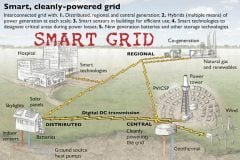
Biomass in the form of fuelwood was perhaps the first energy source used by human beings and was the main fuel till the industrial revolution, after which fossil fuels like coal and oil replaced biomass as the main fuels. Biomass is still an important fuel in developing countries. As per International Energy Agency, biomass energy accounted for 11% of the world’s final energy consumption in the year 2001 (Karekezi, Lata and Coelho 2004). This percentage was 18% for Latin America, 25% for Asia and 49% for Africa.
Biomass energy offers several advantages in the form of energy security, socio-economic development and environment.
Energy security
Decentralized biomass energy could help nation to substantially reduce dependence on fossil fuels.
Rural economic growth
Biomass energy could stimulate growth in farming, forestry and rural industry leading to overall rural development. Biomass energy could also provide a productive avenue for using agricultural and forestry wastes, besides plantations.
Environmental protection
By offsetting fossil fuel use and related emissions of nitrogen oxides, sulfur dioxides, and other pollutants, biomass energy will contribute to cleaner air and water. Furthermore, increased cultivation of carbonfixing plants will help mitigate greenhouse gas emissions that contribute to global.
It is estimated that around 2.4 billion people in the world depend primarily on biomass fuels to provide energy for cooking. Apart from cooking, biomass fuels are also used for process heating, steam generation, mechanical and shaft power, transport fuel and electricity production.
- fuelwood,
- agricultural residues such as husks and stalks,
- vegetable oils and
- animal wastes.
In recent year’s , world has seen tremendous interest in biofuels, and a large research effort is focused on finding new biomass resources and processes for production of biofuels.
A variety of physical, thermo-chemical, chemical and biochemical processes are used for converting biomass into energy. In this chapter we will look into three modern biomass energy technologies (refer table 1.1) which can be applied in a decentralized manner and have proved to be useful in developing country context.
Table 1.1. Decentralized modern biomass energy technologies
| Technology | Type of biomass | Conversion process | End use applications | Technology Status |
| Biomass gasification | Wood, woody biomass, agro and agro industrial residues | Thermo-chemical process which converts biomass into producer gas | Power generation: 10kW -1000 kWe. Thermal applications in small industries up to 3 MWth. | Dual fuel and 100% gas engine based gasifiers available commercially |
| Biogas | Animal dung | Bio-methanation process which converts biomass into biogas | Cooking in households, Motive Power and Electricity generation | Dung-based plants commonly being built. |
| Biofuels | Non-edible vegetable oil seeds | Extraction of bio-oil from the oilseeds. Bio-diesel production through trans-esterification | Motive power and Electricity generation | Bio-diesel and Straight Vegetable Oil (SVO) demonstrated as fuels for transportation and power generation. |
Source: Gokhale, Gupta, Kishwan et al. (2007)1 Modern biomass energy technologies results in making available larger quantities of high-quality energy.
Generally, the conversion efficiencies are much higher compared to the traditional biomass energy technologies (e.g. traditional wood burning cookstove) and usually these processes also generate large amount of nutrients for sustainable agriculture e.g. slurry from a biogas plant, oil seed cake of vegetable oil seeds (Karekezi, Lata and Coelho 2004) .
Succesfull project
One of the first successful applications of biomass gasifier for rural electrification in an off-grid mode is 500 kWe gasifier plant set-up at Gosaba island of Sundarban in India.
The plant was set-up in 1997 and consists of 5 x 100 kWe units. The gasifiers are closed-top downdraft systems based on woody biomass. The plant has dual-fuel engines. The transmission and distribution line is spread over a length of 6.25 km of high-tension line and 13.67 km of low-tension line. The plant serves around 900 consumers. The plant is managed by a local co-operative and the state government.











Any related articles to palm oil mill boilers?